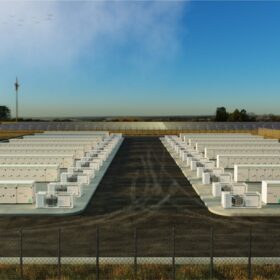The role of battery storage on the grid was a major focus of the RE+ Mid-Atlantic conference in Philadelphia last week. In addition to numerous storage vendors and consultants on the show floor, a panel of experts assembled to discuss storage strategies for the PJM interconnection area, covering the Mid-Atlantic region.
There was broad agreement that successful storage implementation requires clear and purposeful policies at the state level. At the same time, the levels of storage capacity envisioned as an aspect of the clean energy transition may exceed the experience of policymakers, utilities and developers.
“I think it’s fair to say that in PJM there’s been less storage deployment than in other areas that we’ve seen, such as California, New England and New York,” said panel moderator, Nitzan Goldberger, director of policy and business development at New Leaf Energy, a Massachusetts-based renewable energy developer. “We’re going to try to understand not only why that’s happened – what are the obstacles and challenges to getting storage in the ground in the PJM footprint? – but also what are we doing about it?”
From a utility standpoint, the problem seems to be ambitious targets with no clear roadmap showing how to achieve them. Erik Henlon, senior manager of distribution planning at Baltimore Gas and Electric, one of the utilities under the Exelon umbrella that serves the PJM region, said the conversations with stakeholders is still at the early stages.
“From a distribution planning perspective, we look at how we’re enabling all these new technologies to help meet the Maryland goals of 3,000 MW of storage by 2033,” Henlon said. “I think that we starting on the journey, right? And we’re putting the right foundations in place because for us to be able to utilize this much storage on the system takes a certain level of planning and it takes a certain level of collaboration with different stakeholders.”
If there is a tendency to view storage technology as a solution not only for achieving clean energy targets but also for rectifying what some see as community inequities in legacy generation, this can sometimes obscure the practical steps needed to achieve these results. Tyler Wakefield, associate executive director of the Energy Policy Design Institute, a Baltimore-based non-profit focusing on turning clean energy goals into projects, said specific policies are responsible for a state storage markets, or the absence of them.
In the case of Maryland, Wakefild said the recent passage of the Drive Act mandating utilities support bi-directional charging of EVs and time-of-use tariffs enables customers with behind-the-meter storage to realize energy savings on their bills, promoting EVs and residential storage.
“Unless those time-of-use tariffs are in place, those savings opportunities aren’t really there,” he said. “And then we get into what revenue opportunities are available for private storage assets to take advantage of on the distribution system. And right now, there’s really not much there, and that’s why a lot of the conversation at Maryland is, how do we create a mechanism by which resources can get paid directly for the services they can provide on the grid?”
Specific policies make the difference between storage as a mandate and possible burden on the utility and opportunities for all stakeholders to come out ahead with rate and demand stability. According to Wakefield, other states with healthy storage markets have focused on reducing the distribution system peak. That can save a lot of money for utilities and a lot of money for ratepayers. “But if there’s not a clear mechanism by which storage assets can discharge against that peak, get paid for doing that work, there’s not a revenue generating opportunity that’s meaningful enough to deploy,” he said.
Greg Geller, CEO of Massachusetts-based Stack Energy Consulting, agreed that states that have seen a lot of storage deployed have been willing to allow owners to monetize those services storage enables.
“For instance, in the Northeast, there’s a number of programs, whether it’s Massachusetts, New York, Connecticut, Rhode Island, that recognize storage can do things to reduce the bulk level capacity requirement,” he said. “Or it can reduce distribution level costs, or it can help with emissions, right? So, each of those states has some kind of mechanism in place that allows storage to say, ‘Hey, if you dispatch during these periods and you provide the service and everyone benefits from it, we’re going to pay for it.’ That really doesn’t exist in the PJM region.”
Geller pointed out that targets are nice but if you just have a wholesale market, developers are going to find investors very reluctant to finance storage projects. He said states have to step up and make sure storage is compensated for the different services it can provide.
BG&E’s Henlon said utilities in the PJM region are essentially at the ground floor when it comes to implementing storage, despite ambitious targets like Maryland. However, success in other states and regions could be applicable to the PJM service area.
“Each state is in a different place, right?” he said. “A lot of us look at what’s happening out West or in the Northeast. It takes some time for different states to catch up. So, I think that’s a key thing when we’re thinking about the opportunities to grow storage in our area.”
This content is protected by copyright and may not be reused. If you want to cooperate with us and would like to reuse some of our content, please contact: editors@pv-magazine.com.









By submitting this form you agree to pv magazine using your data for the purposes of publishing your comment.
Your personal data will only be disclosed or otherwise transmitted to third parties for the purposes of spam filtering or if this is necessary for technical maintenance of the website. Any other transfer to third parties will not take place unless this is justified on the basis of applicable data protection regulations or if pv magazine is legally obliged to do so.
You may revoke this consent at any time with effect for the future, in which case your personal data will be deleted immediately. Otherwise, your data will be deleted if pv magazine has processed your request or the purpose of data storage is fulfilled.
Further information on data privacy can be found in our Data Protection Policy.